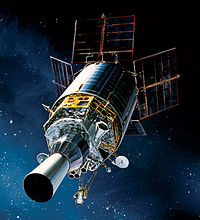Defense Support Program
The Defense Support Program ( DSP ., English for Defense Support Program ) is a missile - early warning military satellite program of the US Air Force . It forms the main component of the US early warning systems against attacks with ballistic missiles.
The satellites have an infrared telescope to track down rockets that are launched, as well as sensors that can detect nuclear explosions. During Operation Desert Storm , the DSP satellites were able to locate launches of the Iraqi Scud missiles and thus provide advance warnings for civilians and military units in Israel and Saudi Arabia.
All generations of the DSP satellites were developed and built by TRW ( Northrop Grumman since 2002 ).
Defense Support Program is being replaced by the Space-Based Infrared System .
technology
The cylindrical DSP satellites rotate around their own axis in order to scan the entire surface of the earth using the angled Schmidt telescope of the infrared sensor. However, the satellites are not spin stabilized , as the satellite's axis of rotation must always be oriented perpendicular to the earth's surface. The satellites use an internal counter-rotating flywheel to compensate for angular momentum.
The satellite's primary sensor consists of a matrix of lead (II) sulfide infrared detectors.
In contrast to most geostationary satellites, the satellites do not have their own rocket drive ( apogee motor ) in order to inject into the geostationary orbit , so that the satellite has to be set down there by the launch vehicle itself. A Titan-3 (23) C was used for the earlier satellites, and later the more powerful Titan-34D Transtage . For the significantly larger satellites in phase 3 , the Titan 4 rocket with an IUS upper stage was primarily used, but the launch could also take place with a space shuttle and IUS upper stage. After the Titan rocket was decommissioned, a Delta IV Heavy was used for the last satellite .
Ground control for the DSP satellites is exercised by the 460th Space Wing at Buckley Air Force Base , Colorado . From there there are communication facilities both to the North American Aerospace Defense Command (NORAD) and to the early warning center of the United States Strategic Command in Cheyenne Mountain near Colorado Springs . These centers relay the information to various government agencies and emergency services around the world.
history
The Defense Support Program was developed in the late 1960s as the successor to the MIDAS system, which also uses infrared sensors . In contrast to the earlier, experimental system, the DSP satellites are in geostationary orbit so that they always observe the same part of the globe.
Since the launch of the first DSP satellite on November 6, 1970, the system has become the backbone of the US missile early warning system. Since the satellite constellation with three satellites achieved near-global coverage with the exception of the polar regions, unnoticed rocket launches had become virtually impossible. In addition to missiles launched with intent to attack, this also included missile tests and satellite launches.
The DSP satellites were continuously developed in the course of the program and increased from the original 900 kg launch mass and 2000 detector elements to 2380 kg launch mass and 6000 detector elements. The planned lifespan of the satellites was increased from 1.25 years to 5 years, with the majority of the satellites exceeding the planned lifespan several times over.
Other technological improvements have been introduced over time, such as: B. Signal processing on board to reduce the number of false positives and detectors to protect the sensors against laser- blend attacks.
Since the Phase II MOS / PIM generation, the satellites can also be deployed from highly elliptical orbits in order to improve the advance warning against rocket launches from the Arctic Ocean. In practice, however, this option was never used.
The Space-Based Infrared System (SBIRS) has been developed as a follow-up project since the 1990s . Instead of scanning sensors, this new generation of early warning satellites has rigid sensors with a significantly faster response time.
commitment
The first use in an emergency took place during Operation Desert Storm , when DSP satellites were able to detect the launches of Iraqi Scud short-range missiles, thus enabling an advance warning for the population and armed forces in Saudi Arabia and Israel .
In the course of the mission it turned out that a number of other events besides rocket launches can also be registered. The system was used to regularly detect explosions and fragmentations of bolides in the earth's atmosphere. The observational data were made available to researchers until 2009. Events that emit strong heat radiation are also registered. Thus, volcanic eruptions , forest fires and explosions are also reported by the DSP satellites.
Satellite generations
| series | number | Start period | Mass (kg) | planned service life (years) | Detector size (pixels) | Remarks | |
|---|---|---|---|---|---|---|---|
| Phase I. | 4th | 1970-1973 | 907 | 1.25 | 2000 |

|
|
| Phase II | 3 | 1975-1977 | 1143 | 2 | 2000 | Extended life |

|
|
Phase II MOS / PIM ( Multi-Orbit Satellite Performance Improvement Modification ) |
4th | 1979-1984 | 1170 | 3 | 2000 | Can be used in various orbits Protection against laser glare |

|
| Phase II upgrade | 2 | 1984-1987 | 1674 | 3 | 6000 | Improved detectors.Reworked phase II satellites |

|
| Phase III (DSP-I) | 10 | 1989-2007 | 2386 | 5 | 6000 | New, enlarged satellite type over-horizon observations possible |

|
DSP starts
| satellite | Build number | date | Launcher | comment |
|---|---|---|---|---|
| Phase I. | ||||
| DSP-1 | SVN-1 | November 6, 1970 | Titan-3 (23) C | Partial success |
| DSP-2 | SVN-3 | 5th May 1971 | Titan-3 (23) C | |
| DSP-3 | SVN-4 | March 1, 1972 | Titan-3 (23) C | |
| DSP-4 | SVN-2 | June 12, 1973 | Titan-3 (23) C | |
| Phase II | ||||
| DSP-5 | SVN-8 | December 14th 1975 | Titan-3 (23) C | |
| DSP-6 | SVN-7 | June 26, 1976 | Titan-3 (23) C | |
| DSP-7 | SVN-9 | February 6, 1977 | Titan-3 (23) C | |
| Phase II MOS / PIMS | ||||
| DSP-8 | SVN-11 | June 10, 1979 | Titan-3 (23) C | |
| DSP-9 | SVN-10 | March 16, 1981 | Titan-3 (23) C | |
| DSP-10 | SVN-13 | March 6, 1982 | Titan-3 (23) C | |
| DSP-11 | SVN-12 | April 14, 1984 | Titan-34D Transtage | |
| Phase II upgrade | ||||
| DSP-12 | SVN-6R | 22nd December 1984 | Titan-34D Transtage | |
| DSP-13 | SVN-5R | November 29, 1987 | Titan-34D Transtage | |
| Phase III (DSP-I) | ||||
| DSP-14 | SVN-14 | June 14, 1989 | Titan-4 (02) A IUS | |
| DSP-15 | SVN-15 | November 13, 1990 | Titan-4 (02) A IUS | |
| DSP-16 | SVN-16 | November 24, 1991 | Space Shuttle IUS | |
| DSP-17 | SVN-17 | December 22, 1994 | Titan-4 (02) A IUS | |
| DSP-18 | SVN-20 | February 23, 1997 | Titan-4 (02) B IUS | |
| DSP-19 | SVN-? | April 9, 1999 | Titan-4 (02) B IUS | unusable orbit due to errors in IUS advanced level; Satellite is used for technological experiments. |
| DSP-20 | SVN-? | May 8, 2000 | Titan-4 (02) B IUS | |
| DSP-21 | SVN-? | August 6, 2001 | Titan-4 (02) B IUS | |
| DSP-22 | SVN-? | February 14, 2004 | Titan-4 (02) B IUS | |
| DSP-23 | SVN-? | November 11, 2007 | Delta-4H | First operational flight of the Delta-4H. Complete failure of the satellite in September 2008, so far (Dec. 2008) no confirmation by the US Air Force. |
swell
- Air Force Space Command DSP Fact Sheet
- James J. Rosolanka, USAF: Defense Support Program (DSP) - A Pictorial Chronology 1970–1998 ( Memento of March 9, 2016 in the Internet Archive ) (PDF file; 26.76 MB)
Individual evidence
- ^ Defense Support program. FAS archived from the original on February 7, 2008 ; Retrieved August 14, 2007 .
- ↑ Fred Simmons, Jim Creswell: IR Eyes High In The Sky. The Defense Support Program. (PDF) In: Crosslink Summer 2000. 2000, pp. 20–27 , accessed on December 4, 2012 (English).
- ↑ Astronomers lose access to military data nature.com; Military Hush-Up: Incoming Space Rocks Now Classified space.com, accessed April 24, 2014
- ^ US satellite failure revives tracking concerns. (PDF) Archived from the original on January 26, 2009 ; accessed in 2008 .



